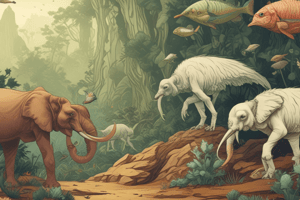Podcast
Questions and Answers
Which of the following is NOT a characteristic of parapatric speciation?
Which of the following is NOT a characteristic of parapatric speciation?
- Populations are geographically separated. (correct)
- Populations experience different environmental conditions.
- Genetic divergence occurs over time.
- Reproductive isolation can develop between populations.
In the stepping-stone model of parapatric speciation, what is the primary factor driving divergence?
In the stepping-stone model of parapatric speciation, what is the primary factor driving divergence?
- Complete isolation between populations.
- Gene flow restricted by limited dispersal between patches. (correct)
- Rapid evolution of new traits due to genetic mutations.
- Sudden environmental changes that create new habitats.
Which of the following examples best illustrates the clinal speciation model?
Which of the following examples best illustrates the clinal speciation model?
- Lizards on Martinique Island with genetic divergence across environmental gradients. (correct)
- Houseflies bred under different conditions showing mating preferences.
- Little Greenbul populations across ecological zones with genetic discontinuities.
- Metal-tolerant plants near toxic mines evolving reproductive isolation.
How does the housefly experiment demonstrate parapatric speciation?
How does the housefly experiment demonstrate parapatric speciation?
What is the key distinction between peripatric and parapatric speciation?
What is the key distinction between peripatric and parapatric speciation?
What is the main factor that drives speciation in allopatric speciation?
What is the main factor that drives speciation in allopatric speciation?
Which of the following is NOT an example of allopatric speciation?
Which of the following is NOT an example of allopatric speciation?
What is the key feature that differentiates peripatric speciation from vicariant speciation?
What is the key feature that differentiates peripatric speciation from vicariant speciation?
Which of the following is a consequence of the founder effect in peripatric speciation?
Which of the following is a consequence of the founder effect in peripatric speciation?
What is the primary driving force behind adaptation in peripatric speciation?
What is the primary driving force behind adaptation in peripatric speciation?
How does parapatric speciation differ from allopatric speciation?
How does parapatric speciation differ from allopatric speciation?
What is the significance of the example of Eastern Asian and Eastern North American angiosperms?
What is the significance of the example of Eastern Asian and Eastern North American angiosperms?
Which type of speciation is most likely to occur when a small group of individuals from a larger population is accidentally transported to a new island?
Which type of speciation is most likely to occur when a small group of individuals from a larger population is accidentally transported to a new island?
Flashcards
Clinal Speciation
Clinal Speciation
A process where a species gradually diverges across varying environmental conditions.
Stepping-Stone Model
Stepping-Stone Model
Populations exist in separate patches with minimal genetic interchange leading to divergence.
Allopatric Speciation
Allopatric Speciation
Speciation that occurs when populations are completely separated by a geographical barrier.
Peripatric Speciation
Peripatric Speciation
Signup and view all the flashcards
Parapatric Speciation
Parapatric Speciation
Signup and view all the flashcards
Speciation
Speciation
Signup and view all the flashcards
Vicariant Speciation
Vicariant Speciation
Signup and view all the flashcards
Founder Effect
Founder Effect
Signup and view all the flashcards
Genetic Drift
Genetic Drift
Signup and view all the flashcards
Natural Selection
Natural Selection
Signup and view all the flashcards
Study Notes
Speciation Mechanisms
- Speciation is the process where populations of the same species diverge, becoming reproductively isolated. This divergence is often driven by geographical separation and genetic differences.
Allopatric Speciation
- Definition: Populations become geographically isolated, preventing gene flow. This isolation leads to independent evolutionary trajectories.
- Vicariant Speciation: A large population is split into smaller groups by a geographic barrier (e.g., Isthmus of Panama, continental drift). This isolates populations, leading to the evolution of new species.
- Peripatric Speciation: A smaller group migrates to a new, isolated area. This small founding population has reduced genetic diversity, which is subject to genetic drift and natural selection. This results in rapid evolutionary changes. (e.g., Hawaiian fruit flies).
Peripatric Speciation
- Definition: A small group of a species colonizes a new, isolated area.
- Key features:
- Founder Effect: The new population has significantly reduced genetic diversity compared to the original population.
- Genetic Drift: Random changes in allele frequencies occur due to the small population size.
- Strong Natural Selection: The new environment often favors different traits, which drive rapid adaptation.
- Examples: Hawaiian fruit flies, Cocos Island Finch.
Parapatric Speciation
- Definition: Populations are adjacent but do not mix freely due to differences in the surrounding environment.
- Clinal Speciation: Populations gradually diverge as they spread across different environments (a continuous change).
- Stepping-Stone Model: Genetic exchange occurs between populations living in isolated patches along a gradient of environmental change.
- Examples: Little Greenbul birds in Africa, lizards on Martinique Island, metal-tolerant plants near mines.
- Evidence: Houseflies bred in different conditions developed mating preferences for their group after generations.
Studying That Suits You
Use AI to generate personalized quizzes and flashcards to suit your learning preferences.




